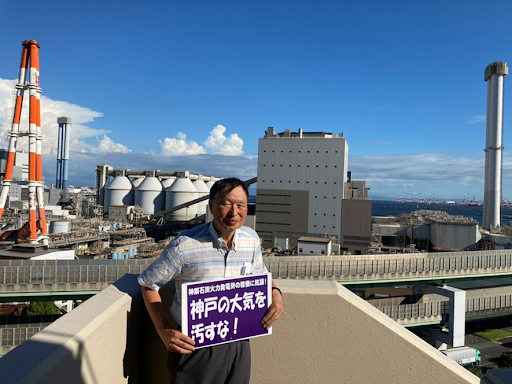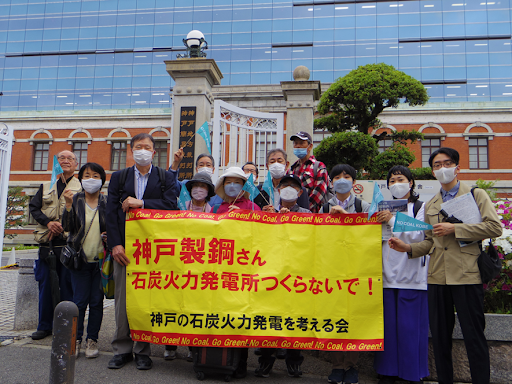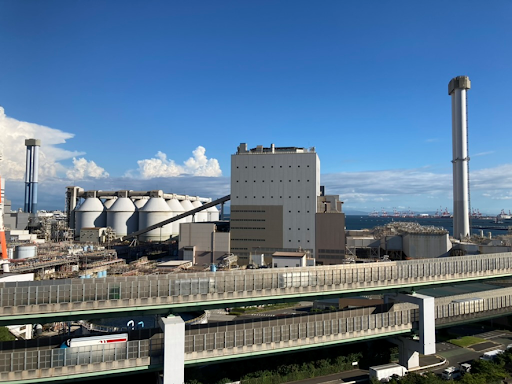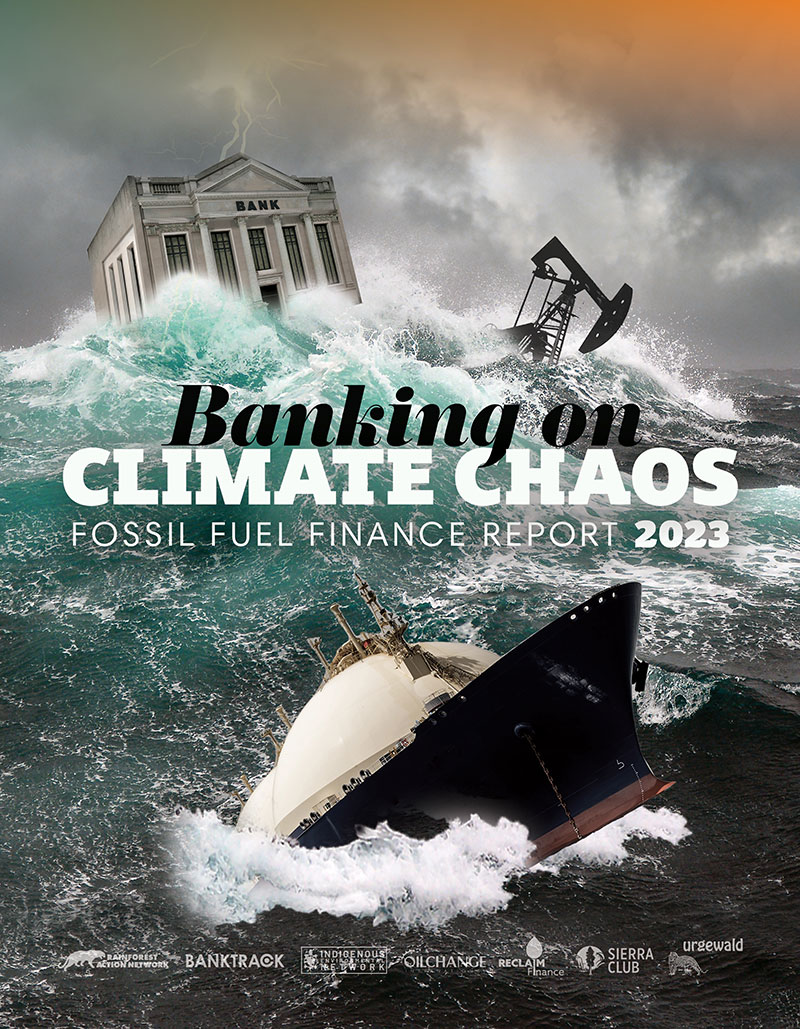This frontline story accompanies the Banking on Climate Chaos: Fossil Fuel Finance Report 2023, produced in collaboration with Kobe Climate Case and No Coal Kobe.
Kobe, a city of some 1.5 million people in Central Japan, has developed into one of the country’s leading port cities. Kobe Steel, one of Japan’s largest steelmakers, has been one of the main drivers of this development. As a diversified company, Kobe Steel is also active in power generation, and operates four coal-fired power units in Kobe through its subsidiary KOBELCO as well as two gas-fired power units in Tochigi Prefecture.
The development of the city, however, has come at the cost of its citizens. One of the threats to their health is the Kobe coal-fired power plant, and its 1,300 MW expansion with the construction of Units 3 and 4, located on a former blast furnace site in Kobe City. KOBELCO began commercial operation of Unit 3 in February 2022 and of Unit 4 in February 2023, both of which are located only 400 meters away from residential areas. Civil society and residents in the surrounding area have been fighting for many years to stop the construction and operation of these units.
Kobe: a history of residents’ resistance against air pollution
Kobe City has a history of serious air pollution.1 Many people still suffer from respiratory diseases like chronic bronchitis, asthmatic bronchitis, and emphysema. In addition, the area’s industry is also emitting enormous amounts of CO2. KOBELCO’s new units add to an already dire situation. All four units from the KOBELCO plant will emit approximately 13 million tons of CO2 annually.2 In addition, the coal power plant also emits large amounts of air pollutants like nitrogen oxide, sulphur oxides, and fine particulate matter. As such, KOBELCO is the largest fixed source of CO2 and air pollution in Kobe City.
Affected citizens have worked hard to advance Kobe City’s environmental administration, fighting long and difficult pollution lawsuits and winning several settlements with defendant companies. One of the most long-standing opponents is Yutaka Hirooka, the representative of the plaintiffs in the Kobe Coal Climate Case, who has been speaking out against the problems with coal-fired power in Kobe for over 20 years. A community group, No Coal Kobe, was also established in 2017 to fight the coal power plant. The voices from residents opposing the construction of coal-fired power plants are getting louder, as climate change is becoming more serious by the day.

Kobe residents take on KOBELCO in court
In 2014, KOBELCO announced plans for the construction of the two coal-fired power units of 650 MW each. From the start, residents have strongly opposed this plan. In the first-ever case of its kind in Japan, Kobe citizens filed a major petition for a pollution mediation process against the Hyogo Prefecture in 2017, demanding the suspension of the construction of the new units and engaging in discussions with KOBELCO. However, in September 2018, KOBELCO notified the start of the construction of Kobe Power Plant Units 3 and 4, even though the pollution mediation between KOBELCO and residents was still in process. Residents then filed a civil lawsuit against KOBELCO, Kobelco Power Kobe No. 2 (a subsidiary for Units 3 and 4), and Kansai Electric Power Company (Japan’s second-largest utility company with a sales agreement with the power plant).
In the court case, the residents argue that climate change and air pollution caused by the massive amount of long-term CO2 emissions from the power plant violate their personal rights, including the right to healthy lives. The residents are seeking an injunction against the construction and operation of the two new units. The trial of this civil lawsuit began in December 2018, and on March 20, 2023, a judgment was rendered dismissing the plaintiffs’ claims. On April 1, 2023, 34 plaintiffs appealed the judgment, and it is currently being heard in the appeals court.

Japanese government and megabanks promote the construction of new coal-fired power plants
For many years, the Japanese government has positioned coal-fired power as a base-load power source and has supported companies to construct or replace coal-fired power plants, especially after the Great East Japan Earthquake in 2011. In doing so, the Japanese government is disregarding the impacts of air pollution and climate change caused by fine particulate matter and other pollutants.
In another attempt to fight for the health of their city, Kobe residents filed an administrative lawsuit against the government in November 2018, challenging the approval of the environmental impact assessment (EIA) for the coal plant expansion. The government should have the duty to protect the health and safety of its citizens by preventing harm caused by power plants. The residents argue that the CO2 emitted by the coal-fired power plant has a significant impact on climate change and constitutes a violation of human rights. On March 9, 2023, the Supreme Court dismissed the case, refusing to recognize the residents’ status and eligibility to sue on the grounds that “the health hazards caused by global warming are not limited to residents in the surrounding area.” The lawyers and residents criticized the court’s decision, pointing out that the outcome will allow the construction and operation of coal-fired power plants to go unchecked.
In addition to the Japanese government, commercial banks Mizuho, SMBC, and MUFG also play a crucial role in fueling the proliferation of coal power plants. Despite all of the opposition from citizens in Kobe, the three banks together provided over USD 1.5 billion in loans for Units 3 and 4 in 2018. Since they signed the loan agreement, all three banks put in place policies excluding finance for new or expanded coal power plants between 2022 and 2023. However, these policies do not apply to the finance provided to Units 3 and 4, even though they only began commercial operation in 2022 and 2023 respectively.

No sense of urgency, only false solutions
The two disappointing court decisions and the three banks providing loans to the project despite the health impacts demonstrate Japan’s lack of a sense of urgency when it comes to climate change and its effects on people. Encouraged by the government and banks, companies are continuing business-as-usual, including by relying on false solutions. KOBELCO’s decarbonization plan, for instance, relies on co-firing ammonia to reduce CO2 emissions from its coal-fired power plants. Switching to co-firing ammonia is also included as a decarbonization strategy in Japan’s GX (Green Transformation) policy and is highlighted as initiatives that MUFG, SMBC, and Mizuho support. This is despite the fact that various reports have pointed out that introducing ammonia co-firing has little effect on reducing CO2 emission.3
Mr. Hirooka says, “Ammonia co-firing on coal-fired power plants is not internationally recognized as an effective decarbonization strategy”, and he calls for widespread citizen support to help win the injunction against the coal plant’s operation in the pending civil case.
Japan’s measures to combat climate change and the policies of its largest banks are highly inadequate, and its continued support for coal-fired power plants will further accelerate the climate crisis. We must continue to voice our criticism until adequate measures are taken.
As Erina Imai, former plaintiff in the Kobe administrative case, said:
The court’s decision in the administrative case seemed to be saying ‘Please wait until the damage from climate change has worsened before coming back to court.’ However, it is too late if we wait until the damage is imminent, with life-threatening extreme weather events being observed in many parts of the world. Outside of Japan, lawsuits have been filed against governments and companies for fossil fuel development. In order for Japan to shift away from coal and fossil fuels, it may be necessary to make the voices calling for the necessity of better climate change countermeasures more visible and to take further legal measures. In any case, we have a role to play in supporting this court appeal, in strengthening the public opinion that climate change is a serious crisis, and continuing the movement.
Learn more and follow the fight at kobeclimatecase.jp/en
- https://www.kankyo.pref.hyogo.lg.jp/jp/keikaku/leg_277/leg_5590/leg_717/leg_735 and https://www.japantimes.co.jp/news/2000/02/08/national/state-appeals-amagasaki-pollution-ruling/
- The KOBELCO plant will emit approximately 13 million tons in total. Units 1 and 2 emit 7 million tons annually while units 3 and 4 are produced to emit 6.92 million tons of CO2 annually. https://www.meti.go.jp/policy/safety_security/industrial_safety/sangyo/electric/files/kobesteelworks/junbisyo_shinsasyo.pdf and https://www.city.kobe.lg.jp/documents/8269/31_r4_h.pdf.
- TransitionZero Japan’s toxic narrative on ammonia https://www.transitionzero.org/insights/japans-toxic-narrative-on-ammonia-cofiring
Kiko Network [Position Paper] Hydrogen and ammonia co-firing in the power sector: Japan is choosing to expand fossil-fuel extraction and perpetuate coal and LNG https://kikonet.org/en/content/31125
Banking on Climate Chaos 2023
The Banking on Climate Chaos report assesses big banks' financing for fossil fuels. These case studies highlight how this financing harms local communities, who are fighting back.









